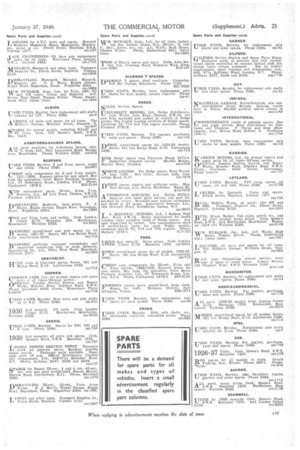Practical Body Design for Specialized Carrying
Page 46

Page 47

If you've noticed an error in this article please click here to report it so we can fix it.
Details of Bodies Suitable for the Transport of Theatrical Scenery, Barrels, Plants, Glass and Bullion, with a Few Notes on a Break
down-lorry Design Design
ORR1ES and trails, with sides
of extra height are, as a rule, "used for the transport of theatrical scenery. A set piece, for example, Made up on a battered framework, has a large superficial area and requires a high side to support it. Even then, the scenery usually projects, above the top of the lorry and, although a waterproof sheet may be used in bad weather, any kind of fixed roof would be an obstruction.
In order to afford good support for
the high sides, the cross-bearers are usually wider than the body. The projection of the cross-bearers provides a. bottom bearing for a short staff or metal stay, which inclines inwards from the Bottom of the body to the waist. It is then continued to the top of the side and is bolted to the standard behind it.
Another unwieldy item, which has El 2 to be carried in the theatrical-scenery lorry, is the rolled-up drop-scene, and the tailboard usually has to be extended to support the rear end.
To reduce the slope of the roll, in such cases, the front of it rests on top of the boarded front of the lorry, this front being an inch or two abcive the cab roof. Above this level there is a cross-rail connecting the tops of the lorry sides, in front.
A pair of intermediate standards is framed into the cross-rail, thus pro
viding, between them and the front corner pillars, three spaces through which the front of a long roll may be inserted.
For the transport of empty barrels, the body of the vehicle should be of maximum capacity and of skeleton construction. The standards may be of channel-section metal, with gussets at the bottom connecting them to the cross-bearers. The horizontal rails„ fastened on the inside of the standards, may be of flat-section metal.
The tops of the lorry sides should be connected with three or four roof ribs, there being a pair of intermediate standards, also a pair of cross-rails to keep in position that part of the load which is carried on the platform above the cab roof.
The florist's van usually has a boxtype body, with shelves for carrying trays of seedlings and plants in pots. If palms or other tall plants have to be transported, then the value of the van is enhanced by having a sliding roof panel.
Large sheets of glass are best carried. on inside sloping racks, one each side of the body. A suitable van may have 10 ft. or 11 ft. of headroom and project half that amount above the cab roof. To reduce wind resistance, a Luton-type sloping front should be built over the cab, or the superstructure might be V-shaped.
Headroom, however, may be decreased to 8 ft. or 8 ft. 6 ins, and provision made for carrying larger sheets of glass oufside the body, on a near-side rack extending below the
floor and above the roof. If garage headroom be restricted, then the top Section of the outside rack may be hinged, to fold downwards. That portion of the outside rack in front of the rear wheel can be made up as a hinged frame, so that it may be lifted to give access to the wheel.
Vehicles used for transporting large kims of money, bullion and other valuables, may be of the normal private or commercial type.
Some are of the opinion that the best way to carry valuables is in as unobtrusive a manner as possible. At the same time, if extra precautions be considered desirable, it should be possible to design a vehicle which appears to have no special protective features, yet is so constructed that the safe keeping of the load is greatly facilitated.
The bullion van may be of a design similar to an ordinary light delivery van. It should have steel panels, of bullet-proof material if required. There would be the usual door on each side of the driving • compartment, whilst the interior of the van could be entered by means of a windowless sliding door in the front bulkhead.
Inside the van there could be a pair of bucket seats with a gangway between them, and behind these a steel chest for the accommodation of the valuable load if it be large and bulky. If the load be small, then there can be a small safe standing on the floor behind the bulkhead.
There would be no windows in the body of the van and ventilation would he afforded by means of louvres under the cant-rail and in the top of the sliding door.
The breakdown lorry is usually a sided-lorry equipped with a crane, towing ambulance and lockers for tools. These vehicles usually have squared-up wheel-arches inside the body. These wheel-arches should not be less than 3 ft. 6 ins, apart, so that there is room for the base of the crane. The last mentioned should haVe a pair of bottom cross-bearers of angle or channel section. These should be securely fastened to the bottom framework of the body, or clipped to the side members of the chassis.
A large tool locker may be built across the front of the lorry, accessible by means of side doors as well as by a lid.




















































































